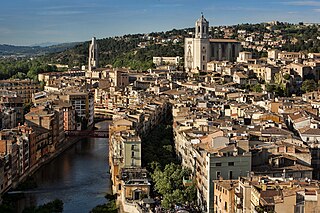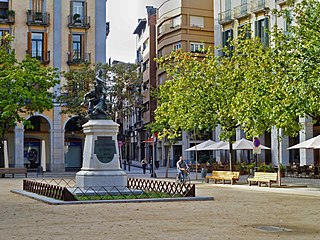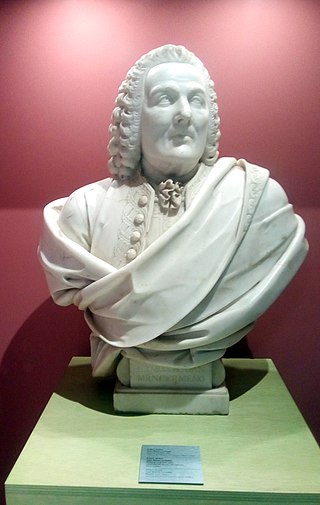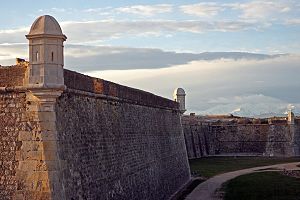
Girona is the capital city of the province of Girona in the autonomous community of Catalonia, Spain, at the confluence of the Ter, Onyar, Galligants, and Güell rivers. The city had an official population of 103,369 in 2020 but, the population of the Girona–Salt urban area is estimated to be about 156,400 (2020). Girona is also capital of the comarca of the Gironès and the vegueria of Girona. Since much of the old quarter of this ancient city has been preserved, Girona is a popular destination for tourists. The city is located 99 km (62 mi) northeast of Barcelona.

Figueres is the capital city of Alt Empordà county, in the Girona region, Catalonia, Spain.

Roses is a municipality in the comarca of the Alt Empordà, located on the Costa Brava, Catalonia, Spain.

The Castle of Púbol or Gala Dalí Castle House-Museum, located in Púbol in the comarca of Baix Empordà, Girona, Catalonia, Spain, is a medieval building where the surrealist painter Salvador Dalí's enormous creative efforts were focused on a single person, his wife Gala, with the aim of providing her with a unique sanctuary and resting place. Gala is buried at the castle. Together with the Salvador Dalí House Museum in Portlligat and the Dalí Theater-Museum in Figueres, they form the Empordà Dalinian triangle.

The Costa Brava is a coastal region of Catalonia in northeastern Spain. Sources differ on the exact definition of the Costa Brava. Usually it can be regarded as stretching from the town of Blanes, 60 km (37 mi) northeast of Barcelona, to the French border – in other words it consists of the coast of the province of Girona.

Empuriabrava is a community in the municipality of Castelló d'Empúries, in the Alt Empordà. It is located in the Gulf of Roses, surrounded by the Natural Park of the Aiguamolls de l'Empordà, and is the largest residential marina in Europe, with some 24 km of navigable waterways.

Brigadier Mariano José Manuel Bernardo Álvarez Bermúdez de Castro y López Aparicio was a Spanish military officer, and the military governor of Girona during the siege by the French during the War of Spanish Independence.

The third siege of Girona occurred in northern Catalonia, Spain from 6 May to 12 December 1809, during the Napoleonic Wars. A significant event of the Peninsular War, France's Grande Armée lay siege to the town of Girona for seven months. Girona was strategically important because it controlled the main road between France and Spain.

The Battle of the Black Mountain was fought from 17 to 20 November 1794 between the army of the First French Republic and the allied armies of the Kingdom of Spain and the Kingdom of Portugal. The French, led by Jacques François Dugommier defeated the Allies, who were commanded by Luis Firmín de Carvajal, Conde de la Unión. Though the Spanish right wing held, its left flank was driven back on the first day's fighting. On the last day of the battle, the French overran a key position and put the Spanish army to rout.

The siege of Roses began on 28 November 1794 and lasted until 4 February 1795 when the Spanish garrison abandoned the port and the forces of the First French Republic took control. Dominique Catherine de Pérignon commanded the French army and Domingo Salvator Izquierdo led the Spanish defenders. The siege took place during the War of the Pyrenees which was part of the French Revolutionary Wars. The war ended in July 1795 and Roses was soon restored to Spain. Roses is a coastal city in northeastern Spain, located 43 kilometres (27 mi) northeast of Girona, Catalonia.

Hostalric is a village in the province of Girona and autonomous community of Catalonia, Spain. The municipality covers an area of 3.39 square kilometres (1.31 sq mi) and the population in 2014 was 4,010.

The Battle of Cardadeu on 16 December 1808 saw an Imperial French corps led by Laurent Gouvion Saint-Cyr assault a Spanish force commanded by Juan Miguel de Vives y Feliu and Theodor von Reding. Saint-Cyr won the engagement by forming most of his troops into gigantic attack columns and smashing through the Spanish lines. Cardedeu is located 17 kilometres (11 mi) northeast of Barcelona, Spain. The action occurred during the Peninsular War, part of the Napoleonic Wars.

The Battle of Girona on 20 and 21 June 1808 saw an Imperial French division led by Guillaume Philibert Duhesme try to overrun a Spanish garrison commanded by Lieutenant Colonels O'Donovan and O'Daly. The French assault failed and the attackers withdrew. Girona is located about halfway between the Franco-Spanish border and Barcelona on the Autovía A-7. The action occurred during the Peninsular War, part of the Napoleonic Wars.

The siege of Roses or siege of Rosas from 7 November to 5 December 1808 saw an Imperial French corps led by Laurent Gouvion Saint-Cyr invest a Catalan and Spanish garrison commanded by Peter O'Daly. After a siege lasting a month in which the haven and town of Roses was captured and the nearby Trinity Castle invested by over 13,000 French and Italian infantry, artillery and cavalry with heavy siege trains on the hills above, the citadel was surrendered to the Napoleonic forces. Roses (Rosas) is located 43 kilometres (27 mi) northeast of Girona, Catalonia, Spain. The action occurred during the Peninsular War, part of the Napoleonic Wars.

The Battle of Molins de Rei or Battle of Molins de Rey or Battle of Molins del Rey saw an Imperial French corps led by Laurent Gouvion Saint-Cyr attack a Spanish army temporarily led by Theodor von Reding and the Conde de Caldagues because its commander Juan Miguel de Vives y Feliu was absent. Saint-Cyr outmaneuvered his opponents, distracting them with a false attack in front while sending the bulk of his force across Llobregat River in a turning movement around the Spanish right flank. The Spanish defensive lines crumbled and the French captured 1,200 soldiers, all the Spanish artillery and Caldagues himself. The Peninsular War engagement was fought near Molins de Rei, located 15 kilometres (9 mi) west of Barcelona, Catalonia, Spain.

The siege of Figueras, which lasted from 10 April to 19 August 1811, saw the Spanish garrison of Sant Ferran Castle led by Brigadier General Juan Antonio Martínez defend against an Imperial French force commanded by Marshal Jacques MacDonald and his deputy Louis Baraguey d'Hilliers. Martínez and his men held out much longer than expected but were eventually starved into surrendering the fortress, which was near Figueres. The action occurred during the Peninsular War, part of the Napoleonic Wars.

Montjuïc Castle is an old military fortress, with roots dating back from 1640, built on top of Montjuïc hill in Barcelona, Catalonia, Spain. It currently serves as a Barcelona municipal facility.

Montjuïc is a hill of the ancient Catalan city of Girona, Spain. Montjuïc is located just to the north of the old quarter of the city, near the confluence of the Onyar, Galligants, and Ter rivers. Montjuïc is also the name of the present-day neighborhood and district of Girona on the hill. The name "Montjuïc" translates from medieval Catalan as "mountain of the Jews". The hill has an altitude of 219 m.

Juan Martín Cermeño, or Zermeño was a Spanish architect, military engineer and lieutenant general.

The Citadel of Barcelona was a bastion fort citadel built in Barcelona. The works commenced in 1714 and, at the time of its construction, it was the largest fortress in Europe, capable of housing 8,000 troops.




















